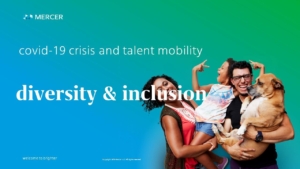COVID-19 crisis and talent mobility:
diversity and inclusion
By Olivier Meier, Mercer
Find out more about cross-cultural solutions for mobile assignees.

The question of diversity and inclusion encompasses all aspects of what makes individuals unique: not only their country of origin and language but also their gender, family status, professional background, education, thinking style, sexual orientation, and generation.
Fostering diversity and gender parity in the mobile workforce has been a perennial problem for companies. Many candidates for international assignments dismiss themselves due to perceived lack of support or are rejected because of unconscious biases. The low representation of women and minorities in the mobile workforce has an impact on diversity at managerial level.
1. Ensuring the wellbeing of a diverse mobile workforce
The COVID-19 crisis creates more difficulties for the mobile workforce and not all employees are equal when facing these challenges. The crisis has shown that companies need to go beyond basic duty of care and focus on employee experience and wellbeing. Highly mobile employees might face health problems, but their wellbeing is also affected by less visible factors, such as stress, financial worries, and mental health issues. Fostering diversity is about recognizing and addressing the specific needs of all employees.
Inclusion itself is a wellbeing issue. Creating a sense of connection with a wider community at work and in the daily life is a condition for mobile employees to thrive in their new locations. This goes beyond just providing cultural trainings and requires appropriate inclusion programs as well as support groups.
2. The challenges of remote working
The rise of remote working during the crisis has allowed many organizations to maintain business continuity and employees to perform their jobs. Going forward, remote working and virtual assignments open up new possibilities for employees to work from home or from a location of their choice. Not all employees are equally prepared for remote working and they don‘t all face the same challenges at home. For example, single parents can face disproportionate difficulties. They may require additional help or more flexibility in working arrangements.
Helping remote employees set up an appropriate work environment and maintain a healthy work-life balance is essential to ensure their productivity and wellbeing.
3. Inclusion and virtual assignments
Virtual assignees can end up being outsiders because they do not master the unspoken codes of the group and are victims of misconceptions.Virtual meetings can amplify stereotypes based on appearance, gender, and accents. A camera does not convey body language and foster empathy in the same way as a real life meetings. Not all participants in virtual meetings have the same innate degree of assertiveness depending on their personality and experience with virtual tools.
In the absence of training and preparation, the risk of falling by the wayside in the virtual world is significant.
4. Financial impact of the crisis
This crisis is a marathon. Economic consequences will stack up over time and require constant monitoring. Companies cannot solve all financial issues but need to be mindful of the impact of the economic crisis on employees and their families. Dual income families, single parents, employees who have to care for sick or elderly family members and other specific groups might struggle financially during the crisis.
Setting up and adjusting assignee packages is only one part of the overall employee financial equation. Companies need a broader approach covering items such as benefits gaps, financial advice and spouse support.
5. Hardship locations: not all assignees are equal
Assignees can be the target of discrimination because of their nationality, ethnicity, religion, social class, gender, sexual orientation, disability or age. This is further complicated by the fact that some minorities are invisible. Furthermore family members of the assignees can also be the target of discriminations. HR teams might not be aware of these issues. The COVID-19 crisis has increased social tensions, inequalities and fostered resentment against foreigners in some countries.
Duty of care and support in hardship locations should be reviewed with diversity in mind.
6. Fewer opportunities or new opportunities?
The future of mobility is uncertain. Cuts in the number of new assignees could affect employee groups that are already under-represented in the global workforce and limit learning and career opportunities. On the other hand, new forms of mobility including shorter assignments and moving jobs to people could open up new opportunities for employees who would normally not be able to go on international assignments. These new forms of mobility could reconcile the cost saving, agility, and diversity imperatives.
More than ever, diversity and inclusion should be part of the discussions about the future of talent mobility.



